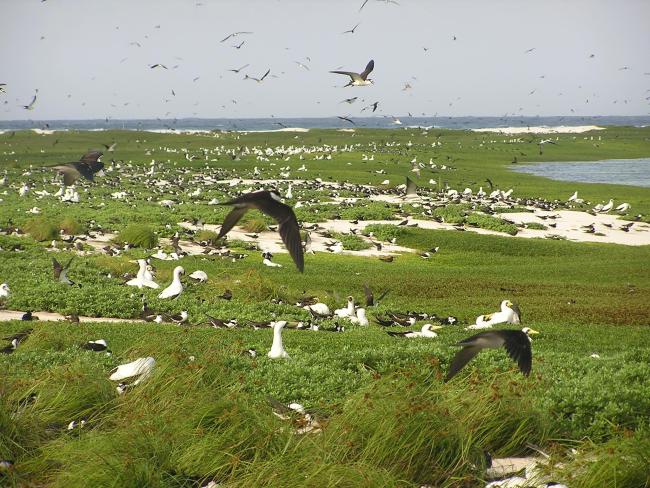Atol das Rocas Biological Reserve
Atol das Rocas Biological Reserve
- Country:
- Brazil
- Site number:
- 2259
- Area:
- 35,186.4 ha
- Designation date:
- 11-12-2015
- Coordinates:
- 03°51'S 33°46'47"W
Carousel
CarouselMaterials presented on this website, particularly maps and territorial information, are as-is and as-available based on available data and do not imply the expression of any opinion whatsoever on the part of the Secretariat of the Ramsar Convention concerning the legal status of any country, territory, city or area, or of its authorities, or concerning the delimitation of its frontiers or boundaries.
Atol das Rocas Biological Reserve is an oceanic island ecosystem which includes the only atoll in the South Atlantic, formed predominantly by coralline algae rather than corals. Located 267 km north-east of the coastal city of Natal, it is also part of the “Brazilian Atlantic Islands: Fernando de Noronha and Atol das Rocas Reserves” World Heritage site. Atol das Rocas hosts a great variety of endemic and migratory species, of which some are endangered and many of economic interest. It is an important reproductive site for green turtle (Chelonia mydas), and also hosts Hawksbill turtle (Eretmochelys imbricata) and loggerhead turtle (Caretta caretta), all categorized as endangered or critically endangered on the IUCN Red List. It also maintains at least 14 endemic mollusc species, including six which are endemic to the Site; five species of sponges not recorded in neighbouring areas and probably new to science, therefore provisionally considered endemic to Atol das Rocas; and 15 species of corals endemic to Brazil. It accommodates the largest concentration of tropical seabirds in the western Atlantic, with an estimate of at least 150,000 birds of 29 species. It is also an important breeding, feeding, and nursing site for lemon shark (Negaprion brevirostris) and hosts five endemic species of fish. Recreation and tourism are not permitted, and only research and monitoring are conducted. The main threats to the Site’s ecological character include illegal fishing, introduction of invasive species, disturbances caused by visitors, and commercial and military overflights.
Administrative region:
Rio Grande do Norte
Global international designation:
- World Heritage site
National legal designation:
- Biological Reserve - Atol das Rocas (Est. June 1979)
Last publication date:
17-02-2016
Ramsar Information Sheet (RIS)
- BR2259RIS_1602_en.pdf
- BR2259_map1509.05.15 - ADJUSTED.JPG
- BR2259_mgt1510.pdf
Site map
Additional reports and documents
Site management plan
Other published literature



